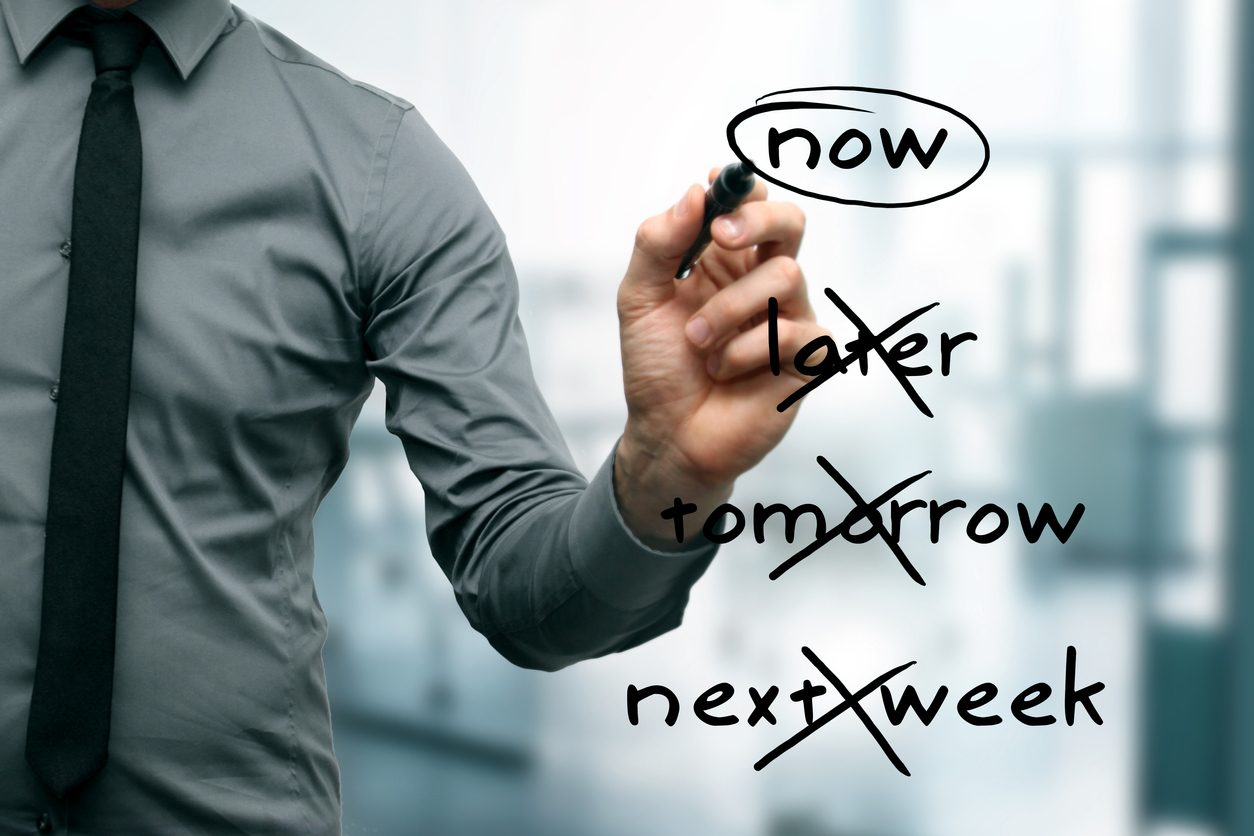
Procrastination is a problem that can affect anyone of all ages and in all walks of life. It's something we're all familiar with, and many people struggle with it on a daily basis. No matter the task we're supposed to be doing, the urge to put it off can be strong. But why do we procrastinate, and how can we stop it? Imagine how much more productive we could be if we can figure out how to put an end to this behavior — we could have more time for the things we love, become more successful in business and life in general, and feel better about ourselves, too!
September 6 is Fight Procrastination Day, and we at 3dcart are joining the battle. We reached out to business owners and experts to find out their favorite strategies, tools, apps, and other tips for overcoming procrastination at work and at home. The expert testimony we received is sure to help you manage your time and develop your own methods to beat procrastination once and for all.
Mark Webster – Co-Founder, AuthorityHacker.com
On structuring your time for increased productivity:
 "It's safe to say I've been guilty of procrastination more times than one. The important thing to understand is that it's perfectly natural. Fight it too hard and you'll end up demotivating yourself and end up burning yourself out.
"It's safe to say I've been guilty of procrastination more times than one. The important thing to understand is that it's perfectly natural. Fight it too hard and you'll end up demotivating yourself and end up burning yourself out.
One strategy I've found useful is to set aside distraction time. I'll set aside blocks of time throughout the day where I can reply to messages, browse the web, decide what I'm having for dinner etc. without the feeling of guilt that comes with it. If you like organization and structure like me, you can even plug these distraction times right into your calendar. That means as soon as it hits 11 o'clock I'll receive a notification letting me know I can take 10 to take a break and stop working.
On the flipside, I'll also create focused work blocks. These are period of time where I absolutely cannot let the outside world disturb my work. They usually only last around 1 hour but during this time, I won't allow myself to get sucked into other tasks or be distracted by team chat (unless of course it's urgent!). This stops me from straying off the path I was on and ensures I complete the job thoroughly without interruption."
Malvika Sheth – Founder and Digital Content Creator, Stylebymalvika
On keeping organized to ensure everything gets done:
 "Owing to the nature of my craft, turnaround time for content is quite rapid — in order to keep my audience engaged, I post well-shot and edited photos 1-2 times a day, and I post at least 4 Instagram stories a day, however some days this number reaches as high as 20 — especially if I’m sharing a full routine of some sort (hair, makeup, etc.). Further, I often have deadlines to meet in terms of brand deals and campaigns, so to avoid procrastination on either of these fronts, I make a list every morning on the notes section of my phone of what has to be done within that day, and I list tasks in terms of priority. Things that are due first and/or might take longer are always listed first."
"Owing to the nature of my craft, turnaround time for content is quite rapid — in order to keep my audience engaged, I post well-shot and edited photos 1-2 times a day, and I post at least 4 Instagram stories a day, however some days this number reaches as high as 20 — especially if I’m sharing a full routine of some sort (hair, makeup, etc.). Further, I often have deadlines to meet in terms of brand deals and campaigns, so to avoid procrastination on either of these fronts, I make a list every morning on the notes section of my phone of what has to be done within that day, and I list tasks in terms of priority. Things that are due first and/or might take longer are always listed first."
On setting personal deadlines and staying accountable:
"Another productivity and anti-procrastination hack is to set deadlines for yourself in places where there might not be a hard deadline — for instance, certain tasks that might just be geared towards your personal goals and dreams. These are still supremely important and should never be on the back-burner, especially if you are an entrepreneur trying to grow your business. It’s always a good idea to set several reminders for yourself either using the reminders app on your phone or else on Google Calendar!
Lastly, speaking of Google Calendar — use it! It’s a great scheduling tool, especially for people who are extra prone to procrastination. Sometimes, going a step further to actually schedule in tasks from that priority list you made earlier, can help you keep yourself accountable so that you finish your intended tasks within the day, and they do not carry over."
Jason Lavis – Managing Director, Out of the Box Innovations Ltd.
On identifying and breaking the habits that lead you to procrastinate:
 "I work on dozens of websites in any workweek, some for clients, and some are my own. My to-do list is never-ending, and it's easy to feel overwhelmed. Being a business owner, and being sat at a desk also means that there are limitless opportunities to check my phone and IPad. My family accept the long hours that I put in to grow my business, but how many of these hours are productive?
"I work on dozens of websites in any workweek, some for clients, and some are my own. My to-do list is never-ending, and it's easy to feel overwhelmed. Being a business owner, and being sat at a desk also means that there are limitless opportunities to check my phone and IPad. My family accept the long hours that I put in to grow my business, but how many of these hours are productive?
I've recently realized two valuable lessons, and both involve procrastination.
Firstly, when tracking my screen time, I've identified a pattern where I check my gadgets, social media and analytics way more often. It's when I'm working on projects that are uninspiring or out of line with my core values. If I choose projects to work on that make me feel like this, then I seem to subconsciously self-sabotage. I notice and react to push notifications, and all manner of distractions seem to pop into my head. Some of my 'busiest' workdays, with the most prolonged hours, are those where I procrastinate but achieve little.
The first solution is to only say yes to exciting work and say no to projects that are a struggle to get motivated on.
The second solution is related to the first, but involve putting my gadgets in a different room, and turning off all personal notifications on my work computer.
These two solutions are a powerful combination."
Patrick Dhital – Co-Founder, Honey Skin
On building motivation by rewarding yourself:
 "There are two tried and tested ways that are vital to improving your productivity and reducing your procrastination. You will never rid yourself of procrastination because that is impossible, and more importantly, does more harm than good. The reason we live in life is to find ways to relax, and you don't have to be a mega multimillionaire to do this. Instead, finding ways to improve productivity is a lot more important. With that being said, time management through meeting short-term goals in set time durations was single-handedly responsible for improving my productivity.
"There are two tried and tested ways that are vital to improving your productivity and reducing your procrastination. You will never rid yourself of procrastination because that is impossible, and more importantly, does more harm than good. The reason we live in life is to find ways to relax, and you don't have to be a mega multimillionaire to do this. Instead, finding ways to improve productivity is a lot more important. With that being said, time management through meeting short-term goals in set time durations was single-handedly responsible for improving my productivity.
When I would be piled with many tasks, I would write down a list, and timeframes for how quickly I need to get these things done. With each activity I finished, I would provide myself with a break. Having these sorts of timeframes really allows you to get things done and can be utilized for anything. For example, if you have a messy room, you can decide to clean up your table and your bed first within an hour and then give yourself a 30-minute break before cleaning up the floor. This intrinsically motivates your mind to finish the task as soon as possible so that you have more break time. Doing this in a professional working environment works very similar to this and is in fact just as effective."
Igor Mitic – Co-Founder, Fortunly.com
On breaking up work time with the Pomodoro Technique:
 "One of the techniques for increasing productivity is the Pomodoro Technique of breaking working time into 25-minute-long intervals. You basically give your best for 25 minutes, after which you have a break. Psychologically, it is much easier to start working if you know you have less than half an hour before you get to rest. The biggest benefit of Pomodoro is that it helps you focus on one task at a time."
"One of the techniques for increasing productivity is the Pomodoro Technique of breaking working time into 25-minute-long intervals. You basically give your best for 25 minutes, after which you have a break. Psychologically, it is much easier to start working if you know you have less than half an hour before you get to rest. The biggest benefit of Pomodoro is that it helps you focus on one task at a time."
On improving focus on work by being prepared:
"One of the reasons why people procrastinate is poor work preparation. Make sure that you have all of your materials in advance including electronics, notes, reports, and even coffee and snacks. When you have everything ready, you will be able to focus just on your tasks. In return, you will be much more productive and may even finish work faster."
On the importance of daily goals:
"It is much easier to start working when you have concrete goals to meet. These goals should be as specific as possible — almost like a bucket list. Ideally, you should estimate the necessary time for each task. Once you have everything written down, you’ll be able to simply follow the list and make sure that you tick every item. Making a list ahead of time will help you prioritize things and feel less overwhelmed with work. Once you are relaxed, you won’t need to procrastinate."
Tony Arevalo – Founder, Carsurance.net
On taking a psychological approach to procrastination:
 "Psychologists say that procrastination reflects on our struggles with self-control and perfectionism. Simply, it’s psychologically more acceptable to never tackle the task than to do something semi-good.
"Psychologists say that procrastination reflects on our struggles with self-control and perfectionism. Simply, it’s psychologically more acceptable to never tackle the task than to do something semi-good.
To fight procrastination I do a few things:
- Make small breaks. If I see I cannot finish some task, or that my productivity is in decline I stop doing it and take a break. This allows me to have some distance from my work and come back to it when I feel the most productive.
- I’m thinking about gratitude. When we’re putting our tasks off, we often feel guilty. However, when we finish them in time we feel relieved and proud of ourselves. When I feel like I will start procrastinating, I think about that great feeling of getting the job done and how guilty I would feel if I fail to achieve it.
- I got rid of all the unnecessary things. Clear desk means a clear mind. To avoid procrastination, I found it most useful to get rid of all the things that might be blocking my concentration."
Dr. Frank Buck – President, Frank Buck Consulting, Inc.
On building a complete anti-procrastination strategy by getting organized:
 "Make your task list irresistible. That's the secret to fighting procrastination. More than the tool you use, it's the way you craft and organize the list. Word tasks so they are crystal clear. When you see that task, you know exactly what to do. When a task is fuzzy, we tend to skip over it and go on to something that is easy. So, break tasks down and word them so they are easy.
"Make your task list irresistible. That's the secret to fighting procrastination. More than the tool you use, it's the way you craft and organize the list. Word tasks so they are crystal clear. When you see that task, you know exactly what to do. When a task is fuzzy, we tend to skip over it and go on to something that is easy. So, break tasks down and word them so they are easy.
For a task list that's easy, start by planning tomorrow today. In the evening, look at what's on tomorrow's list. If something's not clear, fix it. If you know something's not going to get done, postpone the date to one that is reasonable. A digital task manager makes it easier. I use Remember the Milk.
Next look at the tasks that didn't get done today. What needs better wording to make it clearer? What should you move to a future day? What needs to stay on the list and roll to tomorrow?
Third, organize the day. I use the priority field to segment my day. The Fab 5 are my five highest priority tasks. In Remember the Milk, I assign them to High priority, and they sort to the top of today's list. The tasks that are OK to do any time this morning receive a priority of Medium and sort below the Fab 5. Next come tasks I want to see this afternoon, designated with a priority of Low. Finally, the tasks for home this evening receive a priority of None, which puts them at the bottom of today's list.
I'm no fan of filling up the calendar with every task. Does that phone call really need to be made at 9:15, or is any time this morning fine? I reserve my calendar for that which is truly time-specific. Everything else goes in Remember the Milk."
Amy Finlay – Co-Founder, Edinburgh IFA
On getting inspired to get moving:
 "I have something that works for me without fail, every time.
"I have something that works for me without fail, every time.
First though, I used to procrastinate a lot more a couple of years ago than I do now. I read a few different books on the subject that didn't really help much. I then read a book by Ryan Holiday called The Obstacle is the Way.
This was a great read and it really changed my mindset and how I approach problems and challenges. When I face any 'obstacle' now, I am more inclined to want to face it head on until it is sorted. I think this has had a knock on effect and reduced my old procrastinating ways.
I am still definitely an occasional sufferer of procrastination though, and if I sit down to start work and I've not quite got the usual focus or drive to get going then there is only one thing for it.
It only takes around 8 minutes and never fails to get me out of the mood of 'I'll just add it to the to-do list for next week' and instead gets me fired up and in to action. Best of all it's free and features Alec Baldwin in his prime. Here it is."
Aaron Rentfrew – Author; Founder and Adventure Coach, AaronRentfrew.com
On going old-school with the Ivy Lee method:
 "I've tried a handful of new apps and tools, but it's just so easy to avoid them and opt for time-wasting when the phone is involved. Old-school methods work the best for me and those I work with. In particular, many of my clients love the Ivy Lee method. It works due to its simplicity. The strategy reduces decision fatigue and forces you to prioritize. It also helps with stress and the mental fatigue of thinking about 'what do I need to do tomorrow?'
"I've tried a handful of new apps and tools, but it's just so easy to avoid them and opt for time-wasting when the phone is involved. Old-school methods work the best for me and those I work with. In particular, many of my clients love the Ivy Lee method. It works due to its simplicity. The strategy reduces decision fatigue and forces you to prioritize. It also helps with stress and the mental fatigue of thinking about 'what do I need to do tomorrow?'
Under the Ivy Lee method, you write down your six most important tasks to accomplish the following day. It's best to do at the end of the day because all your to-do's will be top of mind. Rank them in order of importance, one being the most important. Only six, and make sure the most critical is right at the top.
The next day, you begin working on the tasks one at a time. You start from number one and do not move to number two until the first one is complete and so on down the list. If items remain undone at the bottom, move them to the following day and repeat the process."
Quinten Lovejoy – Insurance Risk Advisor, QSS LLC, A Division of the Crane Agency
On prioritizing the smallest tasks before they pile up:
 "The most effective procrastination avoidance technique I have utilized is what I refer to as the two minute rule. Very simply: if it takes less than two minutes to do the task, I do the task immediately. Allowing the small things to pile up is what makes the larger things more difficult to focus on and execute.
"The most effective procrastination avoidance technique I have utilized is what I refer to as the two minute rule. Very simply: if it takes less than two minutes to do the task, I do the task immediately. Allowing the small things to pile up is what makes the larger things more difficult to focus on and execute.
My company is QSS, LLC - a Division of the Charles L. Crane Agency. Our commercial insurance practice maintains a large book of medium to large privately owned companies across the nation. Without the steadfast practice of putting out fires that take less than two minutes, we would not be able to properly focus on the larger tasks — nor would we be able to address small issues before they manifest into larger, more time consuming projects. So my advice would be to return that email, respond to the meeting request, write down the calendar appointment — now!
These are small things that will enable you to remain clear and focused so that you can carry out our motto of prioritize and execute. With too much clutter tripping us up on a day-to-day basis, it only makes sense to declutter our lives and our minds in order to better serve our clients, our businesses, and ourselves."
Andrew Alexander – Author, Deconstructing Motivation; Peak Performance Coach, LimitlessAcademy.com
On breaking things down to "The Now Step:"
 "The most important thing to overcome procrastination is to be organized and focus on one specific task. The very first thing you should do is to have a very clear and specific outcome you are working towards. For me, this could be publishing my next book. Then, you take your larger goal and break it down into mid-level sub-tasks. This could be designing the cover or writing 13 chapters for my book. When you have many options to choose from, this could pull you in multiple directions, so you should now break things down to what I like to call The Now Step. The one specific action you can take right now that is the most important thing to move towards your larger vision. If there are multiple ones, choose one and commit to it. It could be to send out the weekly email newsletter, to go onto a job board to recruit a new employee, or something else.
"The most important thing to overcome procrastination is to be organized and focus on one specific task. The very first thing you should do is to have a very clear and specific outcome you are working towards. For me, this could be publishing my next book. Then, you take your larger goal and break it down into mid-level sub-tasks. This could be designing the cover or writing 13 chapters for my book. When you have many options to choose from, this could pull you in multiple directions, so you should now break things down to what I like to call The Now Step. The one specific action you can take right now that is the most important thing to move towards your larger vision. If there are multiple ones, choose one and commit to it. It could be to send out the weekly email newsletter, to go onto a job board to recruit a new employee, or something else.
When you start with the end goal and work your way backwards to the very first step to get there, this provides you the focus and concentration to know exactly where you should channel your energy into. It also removes the overwhelm from all the other things you have going through your mind which leads to analysis paralysis. If you still struggle with actually doing that first step, write a $200 check to a trusted friend, hand it to them, and tell them they get to cash it if you don't complete The Now Step by the end of the day. The fear of loss is usually a really good motivator to get you started.
This strategy is how I stayed motivated to build my first business, a digital magazine publishing company up to 1.3 million readers."
Josh Wardini – Co-Founder, Serpwatch
On dividing up your workload and forgetting about perfectionism:
 "I’m the owner of an IT business and a famous procrastinator who has cured his condition. Being in charge of all the facets of the business, some of the responsibilities I love doing, while the others — not so much. This is where the procrastination kicks in.
"I’m the owner of an IT business and a famous procrastinator who has cured his condition. Being in charge of all the facets of the business, some of the responsibilities I love doing, while the others — not so much. This is where the procrastination kicks in.
So, here are my tips for fighting procrastination.
- Break the workload to smaller manageable chunks. Get manageable chunks of work and work on them individually. This means that if you have a large piece of a project to finish by the end of the day, break it to smaller sub-tasks and approach each one individually.
- Take the easier tasks first. If you are prone to procrastination, take up the easier tasks first, to get your 'engines' started. Psychologically, you’ll feel less burdened because you’ll already have a few tasks ticked off your to-do list.
- Drop perfectionism. Regardless of the nature of your work, know that you shouldn't have the polished result just when you start. Work on version one, two, three, and don't struggle to make it perfect before you've even started.
Using procrastination-fighting methods such as the Pomodoro method can be super helpful with procrastination. If you break your workload to smaller tasks and use the timer set to 25 minutes, you’ll be impressed with the results.
I use the PomoDoneApp, mostly because it has an easy-going interface and you can integrate it to your task manager apps such as Trello, or Slack."
Deborah Sweeney – CEO, MyCorporation.com
On staying organized and motivated with to-do lists:
 "I am a business owner who combats procrastination in a fairly simple way: I make to-do lists and stick to them. Each day, I create a to-do list that outlines everything I hope to accomplish that day. Some of these items may be time sensitive and are organized as my top priorities. Others are less immediate, but may be assignments I would like to start on and are categorized closer towards the end of the list. I review my to-do list throughout the day and cross off everything I have accomplished. It keeps me motivated to stay on task and allows me to feel a sense of accomplishment in knowing I've already done so much!"
"I am a business owner who combats procrastination in a fairly simple way: I make to-do lists and stick to them. Each day, I create a to-do list that outlines everything I hope to accomplish that day. Some of these items may be time sensitive and are organized as my top priorities. Others are less immediate, but may be assignments I would like to start on and are categorized closer towards the end of the list. I review my to-do list throughout the day and cross off everything I have accomplished. It keeps me motivated to stay on task and allows me to feel a sense of accomplishment in knowing I've already done so much!"
Gene Caballero – Co-Founder and CEO, GreenPal
On stimulating your mind by playing an instrument:
 "I am CEO of GreenPal that has been described as Uber for lawn care. I am also a certified personal trainer and graduated with a Psychology and Exercise Science degree.
"I am CEO of GreenPal that has been described as Uber for lawn care. I am also a certified personal trainer and graduated with a Psychology and Exercise Science degree.
My favorite productivity tool is my piano. Playing piano is fun, something I look forward to doing and playing an instrument has been scientifically proven to engage practically every area of the brain at once especially the visual, auditory, and motor cortices so it gets my mental capacity going. It's like a mental full-body workout.
It has certainly help me battle procrastination and gives me a mental jumpstart."
Trivinia Barber – Founder and CEO, Priority VA
On using work management software to maintain organization and accountability:
 "Priority VA is a Virtual Staffing company which specializes in helping entrepreneurs build teams they can trust. Something we’ve discovered in our years of not only working with leaders but also in growing our own business is that teams need accountability. We recommend using a project management tool such as Asana to manage all of your projects. It has by far been the most efficient and easy-to-use software available.
"Priority VA is a Virtual Staffing company which specializes in helping entrepreneurs build teams they can trust. Something we’ve discovered in our years of not only working with leaders but also in growing our own business is that teams need accountability. We recommend using a project management tool such as Asana to manage all of your projects. It has by far been the most efficient and easy-to-use software available.
Within Asana, we apply deadlines to every task and keep most of our communication within the project management software. Every time a task is completed, we let the team know what we did to complete the task.
Accountability comes into play when, at any time and for any reason, we have to move a due date on an assigned task. Regardless of your place on the team, we ask every team member to give a reason why a due date has to be moved. When you’re accountable to someone, you’re less likely to procrastinate. We’ve found that to be the benefit of working with teams and implementing a tool like Asana."
Bradley Hein – Owner, Spectacles Communications
On motivating yourself by focusing on the outcome:
 "As the owner of Spectacles Communications, I work with businesses and nonprofits to elevate brand perceptions and inspire people to act. Using research insights and an innate business understanding, I transform complex information into clear and compelling stories.
"As the owner of Spectacles Communications, I work with businesses and nonprofits to elevate brand perceptions and inspire people to act. Using research insights and an innate business understanding, I transform complex information into clear and compelling stories.
As I primarily work from a home-based office, staying focused and productive is critical. But my global clients such as Prolacta Bioscience, Bags of Fun, and HemaSource, need me at my best at all times.
The key tool I use to stay productive isn’t a product, app or piece of software. In fact, it’s rather old school.
Next to my monitor at all times, I have an image that represents the outcome that every client enables. For Bags of Fun, that image is a hospitalized kid who just received their Bag of Fun. For HemaSource, it’s a clinic expanding to serve more patients because of the supply costs they saved. For Prolacta Bioscience, it’s a family going home from the NICU ahead of schedule because they had proper human-based milk fortifiers.
Each of these powerful visual reminders energize me through the day, and keep me connected to what my clients are doing for the world."
Frank Ramey – Founder, Enotto
On enforcing accountability with management tools:
 "I run a two-man digital marketing agency called Enotto. Our primary niche is hospitality (and primarily cabin rental agencies at that). Since our clients tend to be very seasonal, it’s important we get our marketing efforts out and optimized in a timely manner.
"I run a two-man digital marketing agency called Enotto. Our primary niche is hospitality (and primarily cabin rental agencies at that). Since our clients tend to be very seasonal, it’s important we get our marketing efforts out and optimized in a timely manner.
Even knowing that time is of the essence, since it’s just the two of us, we can sometimes put off getting things done until the last minute.
The reason for that is because we’re the only ones holding ourselves accountable (unless we miss a deadline, then it would be the client holding us accountable!). So we added a third party to help keep us accountable and on track.
That third party is the management tool Asana. We always make sure every task we create is assigned to one of us to be accountable for its completion. We also always set a realistic due date for the task.
Every Monday morning we review the tasks that are overdue and the tasks that are coming due for that week.
While it might sound simple, it’s been astounding how much that simple little act of accountability has helped our business grow and reduce our stress levels."
Kim Hawkins – Owner, EventsWholesale.com
On keeping things streamlined with the Inbox Zero method:
 "The best time management strategy we have used to help fight procrastination is called Inbox Zero. I discovered that I was spending hours each day sifting through emails, and even re-reading older emails that I had left in my inbox. I could pretty much measure my stress by the size of my inbox. The more emails that were piling up, the more time was wasted, and the more stressed I was becoming.
"The best time management strategy we have used to help fight procrastination is called Inbox Zero. I discovered that I was spending hours each day sifting through emails, and even re-reading older emails that I had left in my inbox. I could pretty much measure my stress by the size of my inbox. The more emails that were piling up, the more time was wasted, and the more stressed I was becoming.
One day, I read an article about something called 'Inbox Zero' where you only read an email one time, and then delete it and add it to a to-do list. There are many to-do apps (such as Wunderlist, which we use). I also trained our employees on using the Inbox Zero method. When we receive an email now, we only read it once. If we can complete the task in a couple minutes or less, we go ahead and do that. Otherwise, we add it to our to-do list, and take it out of our inbox to finish when we have time we can dedicate to the task. This has saved us so much time and stress!"
Amber Vilhauer – Founder, NGNG Enterprises
On eliminating clutter and getting things done:
 "I’m an entrepreneur in marketing and sales strategy, supporting authors, speakers and coaches to establish an integrated online presence that gets results. I'm always on a quest to increase my productivity — so much so that I remember coming up with a new writing style for myself in college to more efficiently write notes during class.
"I’m an entrepreneur in marketing and sales strategy, supporting authors, speakers and coaches to establish an integrated online presence that gets results. I'm always on a quest to increase my productivity — so much so that I remember coming up with a new writing style for myself in college to more efficiently write notes during class.
My best anti-procrastination strategy, and this seriously has changed people’s lives, is Get It Done Immediately! For small things especially, like a quick email question, I respond immediately. This frees up my brain space, the time saved adds up quickly and I’m done with it rather than procrastinating and letting it clutter my mind for a longer period of time.
What’s also awesome about this, is clients are thrilled with my response time. If you wait, it builds up in your mind and you feel like you’re not making enough progress and your momentum deteriorates.
Another great tip I encourage you to try is doing a brain dump, or multiple brain dumps throughout the day. Our minds are maxed out with clutter and noise and information and things we want to remember, so how can you possibly expect to get your best work done if you’re full of clutter and things to do? When I have a lot going on in my mind, I can't get anything done well. Instead, have checkpoints throughout the day and brain dump by writing down short- and long-term tasks on a to-do list."
Nancy Butler – Founder, Above All Else, Success in Life and Business®
On getting the hardest things done first (or hiring someone to help you):
 "When self-employed there is so much to do to run the business that it often seems there are not enough hours in the day to get it all done. When looking at the long list of things that need to be done, we often have a tendency to complete the easiest ones or the ones we like doing, first and the tasks we like the least or are the most difficult last. By doing the easier and/or less difficult first, not only can it be less stressful at the time but also, we then feel we that we have made progress getting things done.
"When self-employed there is so much to do to run the business that it often seems there are not enough hours in the day to get it all done. When looking at the long list of things that need to be done, we often have a tendency to complete the easiest ones or the ones we like doing, first and the tasks we like the least or are the most difficult last. By doing the easier and/or less difficult first, not only can it be less stressful at the time but also, we then feel we that we have made progress getting things done.
I find the better way is to do the tasks we like the least and/or are the most difficult first. If you get them off of your plate, you won't have it always on your mind bringing you down. And keep in mind, that as the business owner you don't have to do it all yourself. If there are things you are not good at or truly don't want to do, it is often more appropriate to hire someone who is better at it than you or can be trained to do it more efficiently and effectively. Regardless of your financial position, if you hire and train the right person, they can more than pay for themselves.
Get the most difficult and most challenging tasks off your plate first and your day, week month and maybe even your year can run smoother and be more enjoyable."
Reuben Yonatan – Founder and CEO, GetVoIP
On prioritizing tasks (without overdoing it):
 "Each morning I prioritize my day with no more than 3 big tasks. Of course, throughout the day I'm still peppered with requests, repetitive tasks, etc. However, I've found that prioritizing those is draining, and provides ample excuse to put off what really needs done.
"Each morning I prioritize my day with no more than 3 big tasks. Of course, throughout the day I'm still peppered with requests, repetitive tasks, etc. However, I've found that prioritizing those is draining, and provides ample excuse to put off what really needs done.
To that end, I try to focus on my Big 3 at the start of each day, reset mid-morning, review progress again at lunch, and then push one last time mid-afternoon. With this approach, I manage to knock out at least 1 of those priorities each day, if not multiple."
Vinay Amin – Founder and CEO, Eu Natural
On focusing on long-term goals:
 "Sometimes we procrastinate because we're focused on the short-term outcomes. What's the point of doing this minor, menial, or boring task? Often, the point is not something that produces immediate reward, but reward in the long run. A raise, a positive review, help on another more important task later on.
"Sometimes we procrastinate because we're focused on the short-term outcomes. What's the point of doing this minor, menial, or boring task? Often, the point is not something that produces immediate reward, but reward in the long run. A raise, a positive review, help on another more important task later on.
Sometimes, we put things off because we don't want to do them. They're difficult, boring, or simply your least favorite task. If that's the case, tackle them first. Fight the dragon in the morning, because after that, the rest of your day is a breeze."
Gladice Gong – Founder, Earn More Live Freely
On identifying the most critical goal and breaking it down into steps:
 "I am an entrepreneur, blogger and coach. I run my two businesses from home. My first business is a digital marketing agency, and my second business is an online coaching business. As I work for myself and from home, procrastination is often one of my biggest challenges. So, I have designed a system to help myself stay on track of the goals I want to achieve for my business.
"I am an entrepreneur, blogger and coach. I run my two businesses from home. My first business is a digital marketing agency, and my second business is an online coaching business. As I work for myself and from home, procrastination is often one of my biggest challenges. So, I have designed a system to help myself stay on track of the goals I want to achieve for my business.
Although there are a lot of fancy apps and software to help improve productivity, I still like my ancient white board better. I would write down my ONE goal for my business in big capital letters at the top center of my white board. Personally, I work well with this visual and in-my-face kind of reminder. Then, I would break it down into 3 actionable steps that I have to take consistently every single day. It has helped me stay productive and only focus on doing things that bring me closer to my goal."
Matthew Ross – Co-Owner and COO, The Slumber Yard
On rewarding yourself for completing the boring tasks:
 "I am the co-owner and COO of one of the leading sleep and mattress review websites and YouTube channels (named The Slumber Yard). My company employs 12 individuals in addition to my business partner and is on track to exceed $4 million in revenue this year.
"I am the co-owner and COO of one of the leading sleep and mattress review websites and YouTube channels (named The Slumber Yard). My company employs 12 individuals in addition to my business partner and is on track to exceed $4 million in revenue this year.
As a small business owner who has to deal with many different aspects of running a company, I know how easy it is to get distracted. It's often easier to procrastinate and kick the can down the road, especially when it comes to boring administrative type tasks. For me, I've found that a 1-for-1 reward system works well. In other words, I make myself complete one boring task before I can move on to a more interesting or engaging task.
For example, before I tackle a project related to growth (i.e. the stuff I like to do), I force myself to complete a boring but necessary item like renewing our local business license, paying taxes or processing payroll. I know it may sound childish but I've found this type of carrot system works well and I'd recommend other business owners take a similar approach. It helps keep the necessary but dull aspects of your business front and center so that you never forget."
Vicky Llerena – CEO, SocialVibesMedia.com
On remembering to take a break and recharge:
 "Always take breaks. I can't seem to sit still. I fidget and toss and turn. My legs itch, my head begins to twitch, and I feel uneasy if I sit for too long. This is the problem I had working in corporate. I almost felt forced to sit still. When I ventured into my own business, I felt an ease in taking breaks. Step away from your laptop for 15 min, walk outside, and allow your muscles to relax."
"Always take breaks. I can't seem to sit still. I fidget and toss and turn. My legs itch, my head begins to twitch, and I feel uneasy if I sit for too long. This is the problem I had working in corporate. I almost felt forced to sit still. When I ventured into my own business, I felt an ease in taking breaks. Step away from your laptop for 15 min, walk outside, and allow your muscles to relax."
On finding inspiration and opportunity by connecting:
"Connect with others. I often found that the most interesting conversations happened during the most unexpected situations: on a train ride, at a coffee shop, in line at the supermarket, etc. We love to connect with others; it's part of our inherent human nature. Allow yourself to genuinely connect with strangers (of course, with precautions) because some of these folks might be potential prospects, business partners, or angel investors."
On discovering mentors and keeping yourself accountable:
"Develop mentors in your life. I never claim to know it all nor do I ever want to know it all. My goal is to absorb as much information as possible from my much wiser group of friends. I can attribute mentorship to my growth and success. My mentors have helped me develop habits, open resources, and create a strategy that otherwise would be difficult to figure out. This also helps you create accountability."
On refreshing yourself through mindfulness:
"Mindful Meditation. Mediate when you are alone or even while typing on your laptop. Writing has been a therapeutic process for me as well. Allow your thoughts to flow in a stream of consciousness style (think James Joyce). Prayer or mindful meditation reminds us that there is more to life than a lucrative business plan."
John Rampton – Founder and CEO, Calendar
On scheduling, to-do lists, and prioritizing:
 "My team and I have many ways to avoid procrastination. One of my favorite ways to avoid procrastination is to make sure everything is scheduled. Scheduling is everything for me and my team. Whether it’s a call, meeting, or task, if it’s not scheduled, it is usually unsuccessful. Neither party is prepared, and it takes up unnecessary time. Scheduling things also avoids procrastination by having a set time to complete a task. To schedule things successfully, we have a shared work calendar. This is a nice tool for us to look at when we’re unsure of what a co-worker might be doing at any given time. When there’s nothing scheduled and you need to talk to them, you can see that and proceed to talk to them about whatever it is you need.
"My team and I have many ways to avoid procrastination. One of my favorite ways to avoid procrastination is to make sure everything is scheduled. Scheduling is everything for me and my team. Whether it’s a call, meeting, or task, if it’s not scheduled, it is usually unsuccessful. Neither party is prepared, and it takes up unnecessary time. Scheduling things also avoids procrastination by having a set time to complete a task. To schedule things successfully, we have a shared work calendar. This is a nice tool for us to look at when we’re unsure of what a co-worker might be doing at any given time. When there’s nothing scheduled and you need to talk to them, you can see that and proceed to talk to them about whatever it is you need.
To-do lists are another helpful tool to help avoiding procrastination. I know that there are tasks I need to complete during my work hours, so I know I need to budget my time wisely so I have enough to complete everything I need to complete. Personally, I like to-do lists more than having a calendar, but I know both are necessary for success. Each morning, I write a to-do list of all I know I need to complete that day. This way, I won’t neglect any tasks and can be sure I’ve completed everything successfully. I also thoroughly enjoy checking off tasks on to-do lists. It feels good to get those tasks done.
The last way I like to try to avoid procrastination is to put my hardest tasks at the top of my list. Those are the ones I would otherwise procrastinate. However, if I do them first, I’m getting the harder ones over with and saving the easy ones for last. By doing this, I know I will not wait until the end of the day to do those long and dreadful tasks. I also get a mental break at the end of the day by saving the easy tasks for last."
Suzanne Evans – Founder, Driven Inc.
On becoming a high achiever 15 minutes at a time:
 "I am the real deal! I am on the Inc. 500/5000 Honor Roll by being listed for 5 years in a row, which is an amazing accomplishment. It would be a delight to share my 'ah!' moments along with my many fumbles that made me the business powerhouse I am today.
"I am the real deal! I am on the Inc. 500/5000 Honor Roll by being listed for 5 years in a row, which is an amazing accomplishment. It would be a delight to share my 'ah!' moments along with my many fumbles that made me the business powerhouse I am today.
I am a mom, wife, sister, entrepreneur, and risk-taker from North Carolina. Through my own personal experience of growing my own business, I have helped over 30,000 entrepreneurs and small business owners through my business coaching programs. I am the founder of Driven Inc, my team and I specialize in scaling businesses to 6 and 7 figures and have set thousands on the path to success.
Here is my tip for Fight Procrastination Day: I do everything 15 minutes at a time… sounds crazy, I know! If you look at my schedule everything is broken down into 15-minute segments. When it’s time for checking emails, calling clients or even catching up on social media, that time is blocked out on my schedule in manageable segments. You will be amazed by what you can get accomplished just by breaking down your day!"
Sarkis Hakopdjanian – Director of Strategy + Principal, The Business Clinic
On reducing procrastination by improving the health of the brain:
 "Regardless of how sophisticated the technology or app, no tool can help a person improve their productivity if their mind is agitated, if they feel a high amount of stress and anxiety, if they can’t focus on any one thought or task at a time, or if their mental health is unstable.
"Regardless of how sophisticated the technology or app, no tool can help a person improve their productivity if their mind is agitated, if they feel a high amount of stress and anxiety, if they can’t focus on any one thought or task at a time, or if their mental health is unstable.
There’s a growing body of literature on the scientific benefits of meditation and mindfulness practices to help reduce a person’s stress and anxiety, and improve their focus and productivity. Although this has tremendous long-term benefit to individuals and society, the biggest challenge is that it takes so long to start seeing tangible benefits. Most people get impatient and give up before they start to see any tangible benefits.
In the meantime, there are certain vitamins and minerals that can help us get similar effects. For example, one of my favourite ones is L-theanine, an amino acid commonly found in green tea and some mushrooms. Many research studies have found evidence that it helps reduce stress and anxiety, and improves focus and attention. It also has a synergistic effect with caffeine, further increasing a person’s ability to switch their attention between tasks and stay focused. Early research even shows that it can help minimize some of the effects of ADHD.
Although L-theanine is a great supplement to help business owners and entrepreneurs overcome procrastination and improve productivity, its effects are minor in comparison to the long-term effects that a daily meditation practice can bring. But, L-theanine's biggest advantage is that a person can see results immediately. This can help a person stay focused and motivated to maintain their meditation practice."
Nina LaRosa – Graphic Artist, Moxie Media, Inc.
On fighting procrastination with employee training:
 "As a workplace safety, health, and HR online training and LMS company, Moxie Media provides solutions to a wide range of on-the-job issues. One that seems to affect every industry and company, however, is procrastination.
"As a workplace safety, health, and HR online training and LMS company, Moxie Media provides solutions to a wide range of on-the-job issues. One that seems to affect every industry and company, however, is procrastination.
It’s normal for employees to procrastinate now and again. Sometimes it happens on Monday mornings, when workers are getting back into the swing of things. Or it can occur at the end of the week or at the end of the day, when employees may get lost in thoughts about their post-work plans. In other cases, an employee may feel overwhelmed with work, leading them to procrastinate as a way to try to relieve stress associated with certain tasks.
In any case, employee training on productivity and stress relief can help alleviate the issue of procrastination quickly and efficiently across your workforce. At Moxie, for example, we offer a popular course on Managing Stress on the Job, and we also provide custom course creation for organizations that require more personalized training options. If you are struggling to keep yourself or your employees from procrastinating, consider these tips:
Get organized. If your brain is screaming for a break, give it one that can help put your productivity back on track. Review your calendar or task management tool to make sure it’s organized and up to date. Once you have all your deadlines in order, evaluate them honestly and decide what you need to prioritize first.
Cut back on coffee. Low or moderate amounts of caffeine may improve mental performance, but too much can make it hard to stay focused, potentially leading to procrastination. Instead, try getting enough sleep and eating a balanced diet. When you feel well-rested and your brain has the natural energy it needs, you could find it easier to stay on task.
Stand, stretch, and exercise. Give yourself a short break to get your mind and body back on track. Consider using a standing desk or getting up to do a few stretches or exercises. You might also do a little yoga or meditation to clear your mind. These types of activities can help you feel rejuvenated and ready to work."
Beth Bridges – Author; Speaker and Coach, The Networking Motivator
On splitting up work with tiny lists and the Pomodoro Technique:
 "One of the biggest reasons I find myself procrastinating is because I feel overwhelmed with all that I want to accomplish. So I have two productivity tips that directly address this. First, I extract just a few things from my giant, all-encompassing list and create a tiny list. Sometimes I’ll even write it on a little scrap of note paper. It just doesn’t look all that intimidating that way! It keeps me focused on just a few things as well as keeping myself from thinking about all the other stuff I have to do.
"One of the biggest reasons I find myself procrastinating is because I feel overwhelmed with all that I want to accomplish. So I have two productivity tips that directly address this. First, I extract just a few things from my giant, all-encompassing list and create a tiny list. Sometimes I’ll even write it on a little scrap of note paper. It just doesn’t look all that intimidating that way! It keeps me focused on just a few things as well as keeping myself from thinking about all the other stuff I have to do.
Second, if it’s a really tough day, I’ll use the Pomodoro technique. There are apps for this but basically you just need a timer because the strategy is to just work for 25 minutes, then take a break, usually for five minutes. Then you reset the timer both literally and figuratively. It’s much easier to talk yourself into 25 minutes of focused time rather than thinking you’ve got 8 hours of dread ahead."
Chloe Brittain – Owner, Opal Transcription Services
On her favorite app for goal tracking and building good work habits:
 "I use Strides, a mobile app for tracking goals and setting good habits (or breaking bad ones). I find that the best way to beat procrastination is to train myself to follow a specific power routine every day or every week, and Strides helps keep me accountable by displaying my progress visually, with calendars, charts, and other useful graphics.
"I use Strides, a mobile app for tracking goals and setting good habits (or breaking bad ones). I find that the best way to beat procrastination is to train myself to follow a specific power routine every day or every week, and Strides helps keep me accountable by displaying my progress visually, with calendars, charts, and other useful graphics.
The app also helps with procrastination by visually dividing my goals into manageable portions over a set period of time, so I can see how well I'm keeping pace. For example, if my goal is to write 12 articles in a month, I can easily see at a glance how far ahead or behind I am and how much work I need to do to get caught up. If I'm ahead of schedule on a specific goal, I can consult the app to see how much time I can take off to work on other projects before I start falling behind schedule again. When I divide my long-term business goals into smaller daily pieces like this, I'm surprised at how easy it becomes to stay on track -- and even get ahead of things on a regular basis — as long as I keep my goals realistic."
Drea Gunness-Groeschel – Founder and CEO, Beautiac
On two steps to reduce stress and feel less overwhelmed:
 "Work can be overwhelming, especially if you have a tough boss! I like to follow these steps:
"Work can be overwhelming, especially if you have a tough boss! I like to follow these steps:
2. Make sure you are prioritizing well. This can be tough when you feel the stress and fast pace of a work environment. Ask someone you think is amazing at this skill for tips. Practice makes perfect and it will pace your workload out, so the work days won’t feel so frantic!
I’m my own boss now and continue to follow these steps daily and teach them to those around me."
Rüdrani Devi – Terrorist Attack Survivor; Owner, RudraniDevi.com; Author, Choosing Happiness
On simple, yet powerful stress reduction:
 "When I get stressed, I do three things; stop, breathe and reconnect. Head-tripping is the leading cause of stress and shows up when we make anything significant. In most cases, if we really look at what was tripped up over, it’s not really as important as we think it is. So when my mind is getting the best of me, I stop everything, close my eyes and take deep breaths in and out. I take four counts on the in-breath and eight counts on the out-breath. And I simply watch my breath breathe me in and out like that until I find myself reconnecting with my body. I’ll place my hands on my thighs, give them a squeeze and remind myself that I’m still here, and that’s a lot more significant than anything else could possibly be. This little exercise creates a gratefulness for simply being alive, and isn’t that what we should really be head-tripping over?"
"When I get stressed, I do three things; stop, breathe and reconnect. Head-tripping is the leading cause of stress and shows up when we make anything significant. In most cases, if we really look at what was tripped up over, it’s not really as important as we think it is. So when my mind is getting the best of me, I stop everything, close my eyes and take deep breaths in and out. I take four counts on the in-breath and eight counts on the out-breath. And I simply watch my breath breathe me in and out like that until I find myself reconnecting with my body. I’ll place my hands on my thighs, give them a squeeze and remind myself that I’m still here, and that’s a lot more significant than anything else could possibly be. This little exercise creates a gratefulness for simply being alive, and isn’t that what we should really be head-tripping over?"
Sonja Soderlund – CBD Researcher and Expert, RaveReviews.org
On research into the stress-reduction properties of CBD oil:
 "Anxiety and stress can rob life of its joy and spontaneity, leaving you feeling both tense and exhausted — maybe even depressed and socially isolated. There is promising research that points to CBD’s role as an anxiolytic — which means it has anti-anxiety effects. CBD increases levels of glutamate and serotonin — and it’s these same neurotransmitters that play a crucial role in mood regulation."
"Anxiety and stress can rob life of its joy and spontaneity, leaving you feeling both tense and exhausted — maybe even depressed and socially isolated. There is promising research that points to CBD’s role as an anxiolytic — which means it has anti-anxiety effects. CBD increases levels of glutamate and serotonin — and it’s these same neurotransmitters that play a crucial role in mood regulation."
Brandon Leibel – Co-Founder, Sand Cloud
On taking a break to clear your head:
 "I always find it important to take frequent breaks at work. Even if it’s just a five-minute walk around the office or a stroll down to the beach, taking a step back usually makes me feel more recharged and keeps me focused on the task at hand when I return. I encourage my team members to take time to clear their heads throughout the day, as well, so that we can all bring our best selves to work. We at Sand Cloud believe in working smarter, not harder."
"I always find it important to take frequent breaks at work. Even if it’s just a five-minute walk around the office or a stroll down to the beach, taking a step back usually makes me feel more recharged and keeps me focused on the task at hand when I return. I encourage my team members to take time to clear their heads throughout the day, as well, so that we can all bring our best selves to work. We at Sand Cloud believe in working smarter, not harder."
Evan Mendelsohn – Co-Founder, Tipsy Elves
On remaining clear-headed with daily meditation:
 "Meditate daily. I attended a meditation retreat in Sedona and feel that meditation is so helpful to stay clear-headed, present and intentional throughout my day to day life. The concept of ‘short moments, many times’ is something I've tapped into. You can have small meditative moments throughout the day. It doesn't necessarily need to be long sessions on a cushion."
"Meditate daily. I attended a meditation retreat in Sedona and feel that meditation is so helpful to stay clear-headed, present and intentional throughout my day to day life. The concept of ‘short moments, many times’ is something I've tapped into. You can have small meditative moments throughout the day. It doesn't necessarily need to be long sessions on a cushion."
Stacy Caprio – Founder, Growth Marketing
On blocking distractions with the SelfControl Mac OS desktop app:
 "I like the SelfControl computer app that lets you block distracting sites for whatever period of time you choose. This helps when you're in a mood to simply browse social media or check out cat videos, and gives you no option except to work for the time you choose."
"I like the SelfControl computer app that lets you block distracting sites for whatever period of time you choose. This helps when you're in a mood to simply browse social media or check out cat videos, and gives you no option except to work for the time you choose."
Georgette Blau – Founder and President, On Location Tours
On getting inspired to overcome procrastination (and creating a system to do it):
 "I used to be a terrible procrastinator, the worst kind, until I had my two children, and I realized that I had to be more efficient and stop putting things off. (I even started getting emotional about work tasks, projects, etc., if I would die before I got them done, etc.) After my youngest, I invested into a very light 'train' laptop for my commute, and I get the majority of my emails done to and from home, so that I am able to focus on work at work. In addition, I only put 10 things onto my to-do list every day, no matter what. I was getting more done by putting less. I wasn’t as overwhelmed. And finally, I researched a number of project management software and programs, and decided on Monday.com. We now put everything onto Monday.com, map out our projects, etc., and we are all watching each other to make sure we do not procrastinate."
"I used to be a terrible procrastinator, the worst kind, until I had my two children, and I realized that I had to be more efficient and stop putting things off. (I even started getting emotional about work tasks, projects, etc., if I would die before I got them done, etc.) After my youngest, I invested into a very light 'train' laptop for my commute, and I get the majority of my emails done to and from home, so that I am able to focus on work at work. In addition, I only put 10 things onto my to-do list every day, no matter what. I was getting more done by putting less. I wasn’t as overwhelmed. And finally, I researched a number of project management software and programs, and decided on Monday.com. We now put everything onto Monday.com, map out our projects, etc., and we are all watching each other to make sure we do not procrastinate."
Bryan Mattimore – Cofounder and Chief Idea Guy, Growth Engine Innovation Agency
On streamlining any task via mindmapping:
 "My innovation agency, Growth Engine, leads creative problem-solving workshops for small, medium and large companies. The most effective technique we have found to help entrepreneurs and their teams overcome procrastination is mindmapping.
"My innovation agency, Growth Engine, leads creative problem-solving workshops for small, medium and large companies. The most effective technique we have found to help entrepreneurs and their teams overcome procrastination is mindmapping.
The executives and entrepreneurs we work with procrastinate primarily on 'paperwork': their written reports, presentations they have to create and deliver, and/or annual plans. The reason the mindmapping technique is so effective is that it’s a great way for executives to 'trick' themselves into starting any task they’d rather put off. Our specific counsel: 'You’re not actually writing the report you don’t want to write; you’re just creating a mindmap (which is fun, right?) of the content that will go into the report.'
Once the entrepreneurs and/or their team members have completed their 'content' mindmap, they realize the writing task they were procrastinating on was not so difficult after all, and invariably go on to write it… right away.
A summary of mindmapping:
Mindmapping was invented in the mid-sixties by Englishman Tony Buzan. It is essentially a way to more creatively — and effectively — remember, organize, process, and combine information in the brain. Mindmapping has four key visual-oriented facets/elements that enable users to achieve increased mental efficiency:
- Key Words
- Diagramming
- Symbols
- Colors
Each thought is recorded in one or two representational key words. Relationships amongst key words are shown by diagramming. (Much like diagramming in junior-high grammar classes). Symbols are used to add visual variety and increase memorability. Different colors are used to represent different groups of ideas.
Rationale:
Mindmapping mirrors the way the creative brain processes, records, remembers, retrieves, and re-combines input/stimuli. The right brain thinks visually and associationally. Mindmapping allows the participant to speak the “same language” as the right brain.
As a creative technique, we use Mindmapping to identify 1) 'the facts' about a problem, from which 2) great ideas can grow. We will often have participants do a mindmap/ 'brain dump' on a particular topic (often one they know a great deal about) and use the output from the 'brain dump' (presented in mindmap form) to help other participants get to know a particular subject area better. Then they combine these 'facts' with their own ideas/insights to create new ideas.
Note: Mindmapping can be used for everything from note taking, to speech organizing, memorizing, to writing better business plans.
To Facilitate:
Step 1: Write a key word that represents the problem/assignment on which you are working in the center of the page and circle it.
Step 2: Free associate off of this circled word — writing down everything that comes to mind in key word form. Connect related thoughts with lines — and have them branch off the center word much like limbs from the trunk of a tree. Use different colors to start new branches/limbs off the center key word for thoughts not directly associated with a previous thought. Continue to fill up the page with these diagrammed key words.
Step 3: Draw relevant symbols to improve the visual excitement/memorability of your mindmap.
Step 4: Step back and consider the mindmap as whole. What thoughts/key words — previously unrelated — now seem to be very much related to one another? What are the most important ideas on your mindmap? What might be the most fertile areas for new product development?
Step 5: Now that you have mapped your mind/thoughts on the problem in question, what other ideas does your mindmap suggest?
Step 6: Any builds from the group as a whole."
Jonathan Aufray – Co-Founder and CEO, Growth Hackers
On fighting procrastination with a simple three-part strategy:
 "I am a business owner and most of our team is remote so fighting procrastination is essential for the success of our business and our clients.
"I am a business owner and most of our team is remote so fighting procrastination is essential for the success of our business and our clients.
To fight procrastination, here are my best tips:
- Make a to-do list: you want to create a to-do list at the beginning of each week and each day. This will help you visualize what you need to accomplish. Not only you want to create a to-do list, I recommend you set small milestones and celebrate each milestone you achieve.
- Don't multitask: try to work on 1 thing at a time. Once you've finished with that task, move to the next one.
- Turn off distractions: turn off social media, phone notifications and any other things that make you distracted the most."
Laura Spawn – Co-Founder and CEO, Virtual Vocations
On goal setting, breaks as motivation, and getting the small things done:
 "Setting goals is the best way to beat procrastination and improve productivity — and I'm not afraid to give myself a push in the right direction with a self-imposed deadline.
"Setting goals is the best way to beat procrastination and improve productivity — and I'm not afraid to give myself a push in the right direction with a self-imposed deadline.
One of the things I like do when I just don't feel very motivated is to set a timer for myself for a specific period of time, put on some good music, and tell myself to work until the timer goes off — then, I’ll 'allow' myself a break if I need one. Knowing a break is up ahead keeps me going, but a lot of times, I'll get into a flow and won't want to stop after all!
I don't hesitate to set myself up for success. I'll often take some time at the end of a busy day to complete several fifteen-minutes-or-less tasks, as I call them, like answering emails that have piled up in my inbox or setting reminders to get back to any unfinished business the next day. Even a small win is another step in the right direction."
Leslie Ng – Mindset and Business Coach, LeslieNg.com
On preventing procrastination by examining and changing your mindset:
 "My best tip for fighting procrastination is really to rethink your goal and your desires. Often the reason we procrastinate is because we are avoiding the work because we think it's going to be hard, or take too long, or not be enjoyable, or maybe you think you're not good at it. Whatever the reason is, there is a thought that creates that feeling of overwhelm or dislike that then results in inaction.
"My best tip for fighting procrastination is really to rethink your goal and your desires. Often the reason we procrastinate is because we are avoiding the work because we think it's going to be hard, or take too long, or not be enjoyable, or maybe you think you're not good at it. Whatever the reason is, there is a thought that creates that feeling of overwhelm or dislike that then results in inaction.
To overcome this feeling of procrastination you need to find out why you're avoiding the task. Then shift your perception of it so it becomes something less scary, daunting or overwhelming and where you might even enjoy doing it. One of the easiest ways to do this is to simply flip the thought you're having about the task at hand to the exact opposite. So something like 'this is going to be hard', to 'this is going to easy, I'm good at this'; can help shift that feeling enough to create action."
Zarar Ameen – CEO, Canz Marketing
On the best productivity software for reducing procrastination as a group:
 "It’s not a big secret that there’s a lot of work that needs to be done when you’re the CEO. It isn’t usually the work that’s hard. The trick is getting it all done before the deadline. But it’s not always that easy. We’re only human; sometimes, we lack the inclination or stamina required to do certain tasks.
"It’s not a big secret that there’s a lot of work that needs to be done when you’re the CEO. It isn’t usually the work that’s hard. The trick is getting it all done before the deadline. But it’s not always that easy. We’re only human; sometimes, we lack the inclination or stamina required to do certain tasks.
The best online platform that we at Canz Marketing have discovered to reduce procrastination levels, not just on an individual level but as a group, is Teamwork. It’s excellent software which enables the entire group to collaborate and communicate their weekly tasks to the whole team. There’s a great deal of transparency and ease of delegation within the app. Teamwork never lets you forget that you have an approaching deadline. You’re always aware of how much time you’re wasting (or spending on completing a particular task.) There’s also an enormous amount of satisfaction in crossing out a task before the deadline comes to an end.
Teamwork has a lot of other features which makes it the best tool for keeping procrastination to a minimum, particularly the 'log time' and 'urgency' features. With Teamwork, it’s easier than ever to keep track of productivity levels across the office."
Sid Soil – Founder and CEO, DOCUdavit Solutions
On scheduling, discipline, and tracking your progress:
 "Procrastination is a constant battle that all entrepreneurs must face if they want to achieve success. There always seems to be something more important than the task you're currently doing. Endless to-do lists, family obligations and even mindless social media scrolling tends to take up way more time and brain space than it should.
"Procrastination is a constant battle that all entrepreneurs must face if they want to achieve success. There always seems to be something more important than the task you're currently doing. Endless to-do lists, family obligations and even mindless social media scrolling tends to take up way more time and brain space than it should.
I've found that blocking out a detailed schedule for every hour of the day (not just when I'm in the office) to keep me disciplined and on task. I typically get up early and respond to emails while drinking my morning coffee at home.
When I get to the office and sit down at my desk, it's time to tackle the day's important tasks. I don't look at my email until lunchtime. If there's an emergency, I'm always a phone call away, but the 8-12 block each morning is when I'm most productive in tackling my more difficult, strategic work. Avoiding the constant email bombardment from 8-12 each day gives me 20 hours to devote to expanding my business.
In the mid-afternoon when the creative juices start to slow down, I go back and catch-up on my inbox. I allot a maximum of one hour each afternoon for responding to emails. When 60 minutes is up, I usually take a lap and check-in with my team. That face-to-face check-in helps me stay up to date with their projects and also builds team camaraderie.
Finally, as the workday draws to a close, I spend a few minutes jotting down what I accomplished in a journal and making a to-do list for the next day. When I leave the office, I know what I accomplished and what I need to do first the next day. I don't check my email when I'm at home in the evenings. No email received during dinner is more important than meal time with my family.
By setting a rigid schedule and being overly self-disciplined with my email checking rules, I've managed to get more done faster and free up evenings and weekends for my family. I started developing this routine about 15 years ago and it's evolved over time. I recommend setting some strict rules, sticking to them religiously for at least a month, then reflect and refine until you find an optimal balance of big picture strategic work and day-to-day operational tasks that works for you and your business."
Kate Swoboda – Director, Courageous Living Coach Certification; Creator, Courageous Living Program
On discovering the fears that lead you to procrastinate:
 "When we procrastinate, it's often because we're afraid of something — afraid of the pressure of a deadline, that the right words won't quite flow, or that we have to have the correct circumstances in order to perform well. As someone who juggles multiple roles within a day, between being the Director of a life coach training program, managing a team, coaching, writing, and more, I'm definitely familiar with the feelings of overwhelm — aka, fear — that can lead to procrastination.
"When we procrastinate, it's often because we're afraid of something — afraid of the pressure of a deadline, that the right words won't quite flow, or that we have to have the correct circumstances in order to perform well. As someone who juggles multiple roles within a day, between being the Director of a life coach training program, managing a team, coaching, writing, and more, I'm definitely familiar with the feelings of overwhelm — aka, fear — that can lead to procrastination.
When fear is at the root of procrastination, strategies will only be helpful in the short-term, and the more important work is to face the stress and anxiety that are causing you to avoid doing the work in the first place. Instead of trying to bypass the fear, stress, or worry about a project, examine it more deeply. What's your internal dialogue about this project? What are we telling ourselves about how difficult it will be to start or complete the project — and is it really true that the task or project is difficult, or are we making it more difficult by telling ourselves this? Take out a sheet of paper and finish the sentence, 'With this project/task, I'm afraid that...' This is helpful for zeroing in on what's really going on and figuring out what doubts and stress are the real issue fueling procrastination."
On effective tools and tricks for getting things done:
"Beyond working with our fear, procrastination can be helped by tools that minimize distraction and bolster accountability. It's particularly helpful to turn off phone notifications for all apps or to delete the most distracting apps from devices entirely. At the very least, nest high-distraction apps in folders where you're going to have to swipe or look for them, which can break the habit of turning to those apps regularly. I've used the Feed Eradicator extension on Chrome to hide my Facebook feed, which makes it harder to use Facebook as a distraction.
Apps aren't all bad, however–some can really help with not procrastinating! The app Commit and the Productive app both help someone commit to something, such as regularly working on a project and then checking in daily with whether or not they did what they said they would do. I love the Productive app in particular because there are some tasks that I need to do only on certain days, not every day, and I can customize the app to only ping me on the days when that task is due."
Janie J – Motivational Speaker, JanieJ.net; Author, The Live Your Best Life Series
On playing "mind games" with yourself to change your mindset:
 "As an author of three books with more to be written and published, I am well aware of how much procrastination can hurt my writing career and personal life.
"As an author of three books with more to be written and published, I am well aware of how much procrastination can hurt my writing career and personal life.
I’ll find myself stuck but telling myself to 'Eat That Frog,' or 'Just Do It,' simply doesn’t work. This is especially true if the task has no measurable financial benefit or no tangible benefits in the near future.
This becomes an 'inside job.'
I play a 'mind game' (not an app). It’s a way to change my mindset about a certain chore that cannot be delegated, deleted or delayed but that needs to be done.
Instead of focusing on the guilt of procrastinating (which just makes me feel worse), I focus on the long-range benefits. I tell myself: 'I will be so relieved when X is done. I will be able to focus on more important work once X is completed. Once I do X, everything else will be easier.'
If this ‘mind game’ doesn’t work, my back up plan is just plain bribery! I tell myself: 'When I get this task done, I will be able do Y.' Something I really want to do – like go on vacation!"
Kayla Pendleton – Owner and Founder, Make Her Mark
On effective project and time management:
 "One of the biggest tools I use to fight procrastination is our free project management software, Asana. Every task for my business goes into various project lists with a due date. I assign the task to myself or one of my team members based on priority.
"One of the biggest tools I use to fight procrastination is our free project management software, Asana. Every task for my business goes into various project lists with a due date. I assign the task to myself or one of my team members based on priority.
When it comes to time management, we block out approximate project estimates on our Gmail calendars. We all share our calendars with the team, so we each know what each other’s priorities are.
We have a team meeting once a week to help hold each other accountable to our projects.
This system is great because we can bill our clients based on the time we actually spend on their work, plus we can see how our productivity increases over time.
Pretty cool!"
David Reed – Senior Care Specialist; Founder, Assured Senior Living Solutions
On to-do lists and remembering not to overthink:
 "It's obvious to start by creating a to-do list, but the important thing is to not overthink it. In your head, just know that you can work through the task one step at a time. Check your self-talk to make sure you're not thinking about how overwhelmed you are. Most importantly, form a partnership within your team. If you're an entrepreneur or solopreneur, this might mean looking at your network for someone you could team up with either as an accountability partner or just someone you could outsource some of the work, especially if it is a large task. It helps you stay on task when other people are depending on you to get your part done.
"It's obvious to start by creating a to-do list, but the important thing is to not overthink it. In your head, just know that you can work through the task one step at a time. Check your self-talk to make sure you're not thinking about how overwhelmed you are. Most importantly, form a partnership within your team. If you're an entrepreneur or solopreneur, this might mean looking at your network for someone you could team up with either as an accountability partner or just someone you could outsource some of the work, especially if it is a large task. It helps you stay on task when other people are depending on you to get your part done.
Karla Brandau – Business Coach and Founder, Brandau Power Institute
On changing your mind about a task you dislike:
 "Do a 'mind-flip' when it comes to procrastination. Look at the list of procrastinated items and say 'I CHOOSE to do _________' (fill in the blank with whatever you have been procrastinating). Saying 'I CHOOSE' replaces the victimhood feeling with personal empowerment. It makes you a strong person and overcomes procrastination."
"Do a 'mind-flip' when it comes to procrastination. Look at the list of procrastinated items and say 'I CHOOSE to do _________' (fill in the blank with whatever you have been procrastinating). Saying 'I CHOOSE' replaces the victimhood feeling with personal empowerment. It makes you a strong person and overcomes procrastination."
On when it's okay to procrastinate:
"My philosophy is that it is okay to procrastinate on inconsequential items that could be done. Procrastinating small items that are quick, fun, and easy, gives you more time to muster the mental strength to tackle the important tasks that will advance your career. Fight the urge to procrastinate the career-advancing hard stuff by prioritizing the list, starting on the highest priority, and then using my planning forward technique. As I put items in a calendar on a future date, I label them as a planned forward item, not a procrastinated chore."
Key Points
We've noticed quite a few recurring themes running through our experts' testimony, and one of the biggest is the focus on mindset. This reinforces the idea that procrastination is actually an emotional issue rather than a problem with time management, and that the key to defeating it is to alter your perceptions.
Mindfulness, meditation, and even supplementation can help you center your mind and reduce stress so you're better able to face the tasks in front of you. It's also a huge help to remove any obstacles that could make your work more difficult, like a messy desk or anything else that causes undue effort. If you need to sort through files or hunt down your materials just to be able to start working, you're less likely to begin. This overlaps with getting rid of distractions, since anything that intrudes on your perception can cause you to lose focus — it doesn't have to be a temptation to look at Facebook or "do anything else," it can be as simple as your eyes continually being drawn to a book on your desk. Normally, you might not be so interested in that book, but the temptation to procrastinate will suddenly make the book seem more interesting than the work you're supposed to be doing.
The ability to prioritize your tasks is vital as well, since it will help you get more done and also ensure the important work gets done first. It's worth noting that several of our contributors recommend doing the easiest tasks first, while others endorse the opposite — doing the harder tasks first. This goes to show that different approaches work for different people. One person might feel invigorated by finishing the hardest task, and able to push through the others in record time. However, others may find themselves drained, with the easier tasks seeming more difficult than they normally would. It's ultimately up to you to determine which works best for you, and to come up with a personal strategy that accounts for your motivations and energy levels.
We've also seen quite a few recommendations for work/time management and other organizational apps and software, including:
- Trello
- Slack
- Asana
- PomoDoneApp
- Strides
- SelfControl
- Monday.com
- Teamwork
- Commit
- Productive
- Remember the Milk
- Woven.com
It's great to get so many suggestions because each of these works a bit differently, so you're likely to find one that fits your situation. Whether you work with a team or alone, and regardless of which part of your workflow could use a little help, an app or platform exists to help you.
We'd like to thank all our contributors for sharing their personal experiences and strategies for fighting procrastination. If you have something to share as well, please feel free to make a comment below!





Leave a reply or comment below